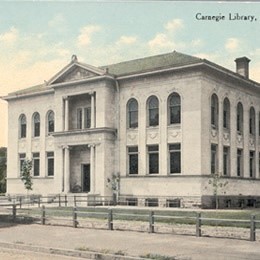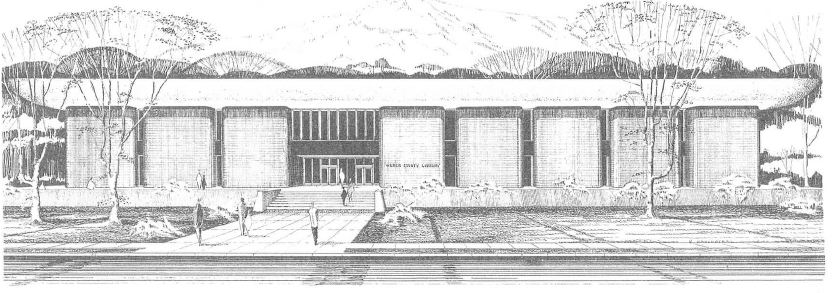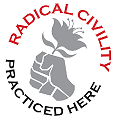
Weber County Libraries: Palaces for the People
Excellence is the goal of everything we do at the Weber County Library, where every day our greatest resource, our people, dedicate themselves to providing the highest level of service to our community. We take seriously our responsibility as a community gathering place and repository of knowledge, offering access to all.
During the course of our 150-year history, library people–board members, friends, employees, and community members–have earned national recognition for our willingness to take risks and power through adversity to help build a world-class library system.
Early History
The Weber County Library System has its roots in the 1864 incorporation of Ogden’s first Library Association; the first, but certainly not the last, attempt to establish collective public access to reading materials. Times were rough and tough in “Junction City” and those groups advocating for collective access to learning materials typically didn’t last long. Over time, however, several associations did succeed in setting up reading rooms that found short-term accommodation in locations as diverse as private homes, local businesses, public buildings, and even an abandoned stable.
Not everyone was welcome. Reading rooms did not pretend to be public libraries and sometimes charged a fee to “rent” books. Nonetheless, they whetted the appetite for more egalitarian access to the printed word.

Utah cities were not authorized to levy a tax in support of the operation and maintenance of a library until 1896, when the first Utah State Legislature met and passed an enabling law. By this time, lack of funding had already hampered public availability of learning materials for more than thirty years. Once the Utah State Legislature took action, a group of community-minded people convinced Ogden City officials to levy a tax sufficient to operate and maintain a public library on the condition that Andrew Carnegie would provide funding for bricks and mortar. A letter was written, Carnegie agreed, and in 1903, thirty-nine years after the first reading room was established, teams of horses pulling carriages, buckboards, and farm wagons lumbered down Washington Boulevard, bringing materials to stock the shelves of the Ogden Carnegie Free Library as it prepared to open its doors. Ogden’s library had the distinction of being the first building in Utah dedicated entirely to public library service.
During the decades that followed, the Ogden Carnegie Free Library served the people as a public library and stayed open until eleven o’clock in the evening to serve as an academic library in support of Weber Academy, which later evolved through several name changes (Weber Normal College, Weber College, Weber State College) to become Weber State University. In 1954, when Weber College outgrew its original home on Jefferson Avenue and moved to its current location on the east bench, it was time for the public library to have a new home as well.
Now more than fifty years old, the Ogden Carnegie Free Library building was completely worn out and lacked adequate space for both patron service and housing the public’s impressive collections. Shelving was moved so close together that an article in the local newspaper reported, “Only a person of lean persuasion was able to make his way between them.” The floors sagged so dramatically under the weight of the books and bound periodicals that, on more than one occasion, readers were quickly summoned to physically brace the shelves while librarians unloaded the stacks so additional shims could be placed on the sagging side to keep them from toppling.
A County Library System is Established
During the late 1950s and early 1960s, the intellectual daughters and sons of those who established those first reading rooms began to envision a new building, a second-generation central library, that would function as the hub of a system with branches having the capacity to serve people throughout the entire county. Their vision for this future was fraught with challenges: political, social, legal, and financial. Nevertheless, they persevered.
As the lions poised on the steps at the entrance to the New York City Public Library attest, Patience and Fortitude pay dividends. Every hurdle was cleared, save the very last: an opportunity for the people to have the final say. Weighing in by way of a public vote, people from throughout the county gave a thumbs up to establish a countywide library system; that is to authorize the sale of general obligation bonds to build a new Main Library–with branches to follow–and to levy a tax for operation and maintenance.
On February 28, 1966, after sixty-five years serving patrons as one of the most beloved and respected institutions in the community, the Ogden Carnegie Free Library Board of Directors voted the library out of existence and a newly established Weber County Library Board took the reins. Construction soon began on a new central library. This time, the community would build a fortress.
The Main Library

John L. Piers was challenged to design and Hogan Tingey to construct a building so formidable that collections could span the one-hundred-foot-wide building without the need of a single support column. It was to be a building designed in the NEW FORMALISM architectural style that paid homage to classic Greek temples, a building so beautiful that it was destined to become a Northern Utah icon.
An adage states that “Nothing worth having comes easy,” and it was certainly true of the first Weber County Library building. Political squabbling, a high water table, and the dismissal of a principled library director delayed construction. Nonetheless, the newly constructed library opened in March 1968, with an official celebration and dedication scheduled on April 4. Expectations ran high for the long-awaited event.
As people were dressing for the occasion, a gunshot rang out in Memphis, Tennessee. An hour later, authorities announced Dr. Martin Luther King, Jr. had been assassinated. News didn’t travel as fast in those days as it does now; there were no cell phones or internet. Nonetheless, by the time the crowd assembled to hear the speeches and prayers that were to dedicate their new temple of learning, the news of Dr. King’s death began to make its way through the gathering. There is no indication that this tragedy changed the course of the planned public events that evening, but his violent passing certainly changed the future course of this institution.
Palaces for the People
Library employees, board members, Friends of the Library, and community members vowed the dedication of the new Weber County Main Library was more than perfunctory speeches and prayers. There was a need for action, for a public commitment to take responsibility for providing all the people with equitable access to a principled public institution; a library, dedicated to a system of ethics that recognizes every person is worthy of respect and that each individual has a right to an irreducible minimum of society’s resources necessary for “Life, Liberty, and the Pursuit of Happiness.”
Over the decades that followed, a bookmobile, four branch libraries–SOUTHWEST BRANCH, NORTH BRANCH, OGDEN VALLEY BRANCH, and PLEASANT VALLEY BRANCH–and the County Law Library were added to the Weber County Library’s administrative umbrella, extending access to print, non-print, and electronic resources to people living throughout Weber County. Like the Carnegie Library before it, the Weber County Library System endeared itself to generations of people, evolving, innovating, and extending services that resulted in earning dozens of LOCAL, STATE, AND NATIONAL AWARDS. For example, during 1984, the Utah Library Association awarded the Library Development Fund their “Community Service Award,” recognizing this group as the only not-for-profit corporation in Utah dedicated to enhancing public library service. The Utah Heritage Foundation recognized library board members with its 2004 “Building Stewardship Award” for their dedication to the outstanding care and maintenance of the Main Library.
Almost Fifty Years and Twenty-One Million Visits Later
On December 1, 2011, a near tragedy awoke a sleeping giant in the library community when an electrical transformer housed in the Main Library’s boiler room malfunctioned. Ogden City emergency responders and utility workers averted a fire and possible explosion only by disconnecting the building’s electrical feed at the utility pole. News of this narrowly averted catastrophe, combined with additional occurrences of electrical fires, floods, and OTHER INFRASTRUCTURE FAILURES focused public attention on the need to take action. More than 21,000,000 visits over the course of almost fifty years had taken its toll. The building now presented infrastructure life-safety issues that had to be addressed.
During 2012, the library board commissioned a feasibility study to be conducted by a team of highly qualified architects and engineers. The team’s charge was to evaluate the Main Library, recommend whether it should be replaced or renovated, and determine the relative cost of each course of action. After six months of exploration and study, the team produced and presented its report to the public. Recommendations included:
- Construct a new headquarters library on the county’s west side to support continued growth and development in this area. The feasibility study team noted that constructing a much needed new library on the west side of the county would afford the opportunity to expand services at both the Main Library and North Branch without incurring the considerable expense of building an addition to either of the existing facilities.
- Relocate the library’s Technical and Support Services divisions housed on the lower level of the Main Library to the new headquarters building, freeing space needed for public programs and services and allowing the downtown Ogden library building to continue to function as the central library for the county-wide system.
- Relocate the library’s in-house print shop and items stored in the lower level of the North Branch to the new Headquarters Library, freeing approximately 12,000 square feet of space necessary for public programs and services.
- Renovate the Main Library to create a safer, more flexible, and energy-efficient facility capable of supporting a new generation of life-long learning applications. The feasibility study team estimated approximately $1,000,000 could be saved by renovating the Main Library rather than tearing it down and starting over.
- Renovate and expand public services into unfinished space at the North Branch Library to create a safer, more flexible, and energy-efficient facility capable of supporting a new generation of life-long learning applications. A second study found it would cost approximately $5,000,000 less to renovate the North Branch than to build a totally new facility of the same size.
- Add parking and storm sewer infrastructure at the Ogden Valley Branch to leverage the public’s investment and ability to safely serve a growing population.
The feasibility study team cautioned that time was short. Catastrophic failure of the Main Library infrastructure was imminent.
Onward and Upward
A five-year capital plan was developed to facilitate recommendations included in the feasibility study, and on June 23, 2013, the people again weighed in on the future of the Weber County Library System. Rallying under the banner, “Libraries Change Lives,” the public voted their approval of the projects outlined in a new capital plan.
The vote of approval to sell general obligation bonds to fund the capital plan came after an AWARD-WINNING PUBLIC INFORMATION CAMPAIGN sponsored by Friends of the Library. The campaign was based around Weber County’s award-winning PLEASANT VALLEY BRANCH that opened during 2009. The Pleasant Valley Branch allowed people to see first-hand how libraries had evolved from their traditional role of housing print materials into modern community platforms for lifelong learning. As it turned out, residents wanted a library like the Pleasant Valley Branch in their community and voted to make it so. United for Libraries, a division of the American Library Association, recognized the leadership of the Friends of the Library in informing the public about the changing role of libraries, by presenting them with their 2014 “Special Project Award.”
A New Generation of Community Learning Platforms
“On time and under budget,” was the mantra during the ensuing five years, as additional parking and storm drain systems were added at the Ogden Valley Branch; a new Southwest Branch/ Headquarters Library was constructed; and the Main Library was completely renovated and expanded. On June 23, 2018, five years to the day the public approved sale of the general obligation bonds, the fourth and final capital plan project, a renovated and expanded North Branch, opened its doors to the public. All four projects were completed on time and under budget
Paying homage to those stewards who had come before during the opening of each new facility, the library board and staff challenged those who will follow to remember that excellence is never achieved by accident. It is always the result of a shared vision, integrity, planning, and hard work.
Looking Ahead
As you visit Weber County’s libraries, envisioned by a new generation of community builders and fueled by a vote of the people, you will find individuals of every description, hailing from every station in life, joining together to attend classes, participate in programs, and enjoy access to educational resources of every description. You will find a diverse, highly educated and skilled staff that comes from throughout the North American continent and beyond. You will see community gathering spaces where everyone is welcome to engage in teaching as well as learning.

You will also find prominently displayed a symbol of this Library System’s commitment to all the people. This symbol, a silhouette of a powerful fist clenching a flower, is our way of signifying that this institution is committed to Radical Civility. Radical Civility is a public service philosophy that is not based upon a narrow set of prescribed values, but rather on universal ethical principles that demand all people be treated fairly, with dignity and respect.
In these community spaces, your public libraries, we will make good on the commitment that people will be judged by “the content of their heart, not by the color of their skin,” or by any other distinguishable characteristic. Radical Civility is what you may expect to see us model, and it is what we expect to see from others.
Thriving on Chaos: The Butterfly Effect
Chaos theory, the science of how, over time, incremental changes in nature result in monumental effects, recognizes that a flap of a butterfly’s wings in Ogden, Utah can change the weather half way around the world. For more than 150 years, the Weber County library community has again and again demonstrated the validity of this theory. Transforming a public reading room housed in an abandoned stable into the nationally recognized community educational platform for life-long learning took more than money, hard work, and time. It took people from every station in our community working together, one small step at a time, in support of a shared vision: Libraries Change Lives.
Thank you for making it so.
Now, let’s imagine what we can accomplish together during the next fifty years, and beyond.
